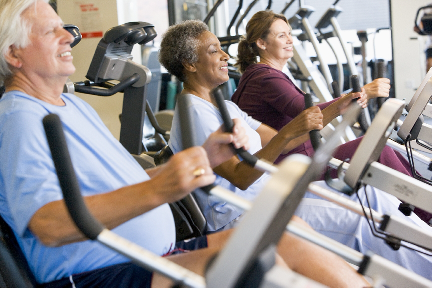 Have you noticed your parents sitting more and more? Throughout the aging process we tend to become less physically active, therefore decreasing our overall strength. This can lead to many health issues, including loss of balance and eventually falls. Falls in seniors are the number-one cause of fatal and nonfatal injuries. As we all know, the older we get, the harder it can be to recover from any type of injury, so let’s help mom and dad prevent what could potentially alter, or even take, their lives.
Have you noticed your parents sitting more and more? Throughout the aging process we tend to become less physically active, therefore decreasing our overall strength. This can lead to many health issues, including loss of balance and eventually falls. Falls in seniors are the number-one cause of fatal and nonfatal injuries. As we all know, the older we get, the harder it can be to recover from any type of injury, so let’s help mom and dad prevent what could potentially alter, or even take, their lives.
Prevention is the keyword. Take a look at these tips to see whether you can do anything for your parents before an accident occurs and you find yourself saying, “This could have been prevented.”
- Speak with your parents about their overall health. Discuss medications and their side effects, as well as health conditions that could cause falls, such as eye or ear disorders. Some medications alone can cause dizziness, while others may have negative interactions when combined, and visual and vestibular impairments and disorders can be large culprits when it comes to falls. It is also important to keep open communication about previous or current falls. This can be embarrassing for the parent, so it is important that they understand that it is not a burden to you, nor should it be an embarrassment to them. Do not take any fall lightly, because not all injuries are obvious or can even be seen without medical testing.
- Make an appointment or two. Encourage your parents to make an appointment with their doctor to discuss their overall health and risk of falls. If possible, ask to sit in on the appointment to help yourself better understand what you can do to motivate your parents to work on fall prevention.
- Help your parents with a home safety checklist. This is as simple as checking your parents’ home for possible hazards that could cause a fall. For example, ditch the throw rug, remove electrical or phone cords from walkways, or add night lights in their bedroom, bathroom, and hallways. Refer to this CDC link for a comprehensive checklist.
- Discuss possible upgrades to existing amenities in their home. Oftentimes, the bathroom can be an easy place to take a tumble, so find out how you can help prevent these types of falls. Speak with your parents about raised toilets, grab bars, and shower or tub seats. Refer here for a more complete list of safety care product suggestions for the bathroom.
- Chat about whether their home is the best place for them. Is downsizing realistically a safer and more convenient environment? This can be a very hard and sensitive topic to discuss but could prevent issues down the road. Consider alternatives, such as smaller homes, condominiums, retirement communities, assisted living communities, etc. Making the decision may be difficult, but it is critical, and the change becomes much easier once they have adjusted. Check out this blog to read about the “Someday Syndrome” that keeps some seniors from making the move.
Stay tuned for part 2 of this series, where I give another important tip that can singlehandedly make a significant change in fall risks. Check out our Balance Training Whitepaper for the importance of balance training for seniors.


 Physical activity and exercise are two different terms that have similar concepts. Physical activity such as gardening, walking the dog, mowing the lawn, shopping, and taking the stairs gets your body moving. Exercise is a form of physical activity that is specifically planned, structured, and repetitive, such as strength training, yoga, or aerobics class. Both physical activity and exercise are great for seniors to keep up the daily activities they enjoy.
Physical activity and exercise are two different terms that have similar concepts. Physical activity such as gardening, walking the dog, mowing the lawn, shopping, and taking the stairs gets your body moving. Exercise is a form of physical activity that is specifically planned, structured, and repetitive, such as strength training, yoga, or aerobics class. Both physical activity and exercise are great for seniors to keep up the daily activities they enjoy. Gardening and lawn work are not only good for cultivating healthy and delicious food and beautiful landscaping, but they are great ways to stay active. Think about all the tools that are used for gardening and yard work: rakes, hoes, wheelbarrows, clippers, shovels, watering cans, and many more. The use of these tools requires the work of all major muscle groups, including your legs, arms, buttocks, stomach, neck, and back.
Gardening and lawn work are not only good for cultivating healthy and delicious food and beautiful landscaping, but they are great ways to stay active. Think about all the tools that are used for gardening and yard work: rakes, hoes, wheelbarrows, clippers, shovels, watering cans, and many more. The use of these tools requires the work of all major muscle groups, including your legs, arms, buttocks, stomach, neck, and back.